Clay pots keep food fresh longer through a remarkable natural cooling system that works like your body's perspiration. When you place food in these porous containers, they regulate temperature and humidity through evaporative cooling, dropping internal temperatures by up to 10°C below the surrounding air. The clay's unique molecular structure maintains ideal humidity levels between 90-100%, preserving food's texture and cellular structure while preventing spoilage. You'll also benefit from the pot's ability to enrich food with essential minerals and neutralize acidic components naturally. The fascinating history and science behind this ancient technology holds even more preservation secrets.
The Science Behind Clay Storage
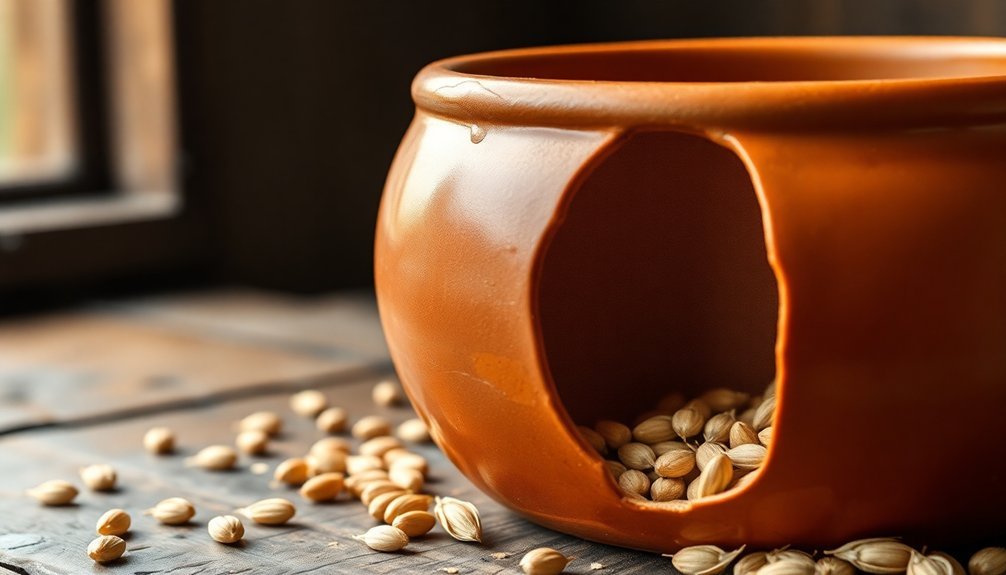
Clay pot storage harnesses the natural process of evaporative cooling, working much like human perspiration to keep food fresh. When water evaporates from the outer surface of the clay pot, it removes heat and converts sensible heat to latent heat, effectively lowering the interior temperature. You'll find that this process can cool the inside by up to 10°C below the surrounding air temperature.
The system relies on a clever double-wall design, where you'll typically see a smaller pot nested inside a larger cylindrical container. The key to its effectiveness lies in the wet sand that fills the space between these two clay walls. As the water in the sand evaporates through the porous clay, it creates a continuous cooling effect. This simple yet effective design has proven particularly valuable in Sub-Saharan Africa, where it helps reduce the 50% loss of harvested produce due to spoilage.
You'll need to maintain proper humidity levels inside the pot, which is why covering it with a damp cloth or sack is essential.
For the system to work effectively, you'll want to place your clay pot cooler in a shady, well-ventilated area. The combination of shade, airflow, and evaporation creates an ideal environment that maintains stable temperatures and humidity levels, helping preserve your produce longer.
Ancient Pottery Preservation Methods
Beyond the science of clay storage, you'll find fascinating preservation methods dating back thousands of years. Ancient civilizations developed ingenious techniques to repair and maintain their precious pottery vessels, ensuring they'd continue serving their food preservation purposes effectively.
When pots cracked or broke, craftsmen would use metal pins made of copper, lead, or bronze to hold pieces together, while animal or vegetable-based adhesives provided additional bonding strength. The practice of using soluble salts in repair work often led to surface deterioration when exposed to humidity changes.
You'll notice that ancient repair work often incorporated fragments from other vessels to replace damaged sections. These replacement pieces didn't always match the original decorative elements, creating unique hybrid vessels that tell stories of resourcefulness and practicality.
This approach changed dramatically during the 18th to early 20th centuries, when restorers aimed to make repairs virtually invisible, concealing any evidence of damage.
Today's conservation methods draw inspiration from these ancient techniques while embracing modern scientific principles. You'll see a focus on reversible materials and non-destructive methods that preserve the pottery's history.
Conservators now use specialized adhesives and fillers that you can distinguish from the original craftsmanship, ensuring authenticity while maintaining the vessel's structural integrity.
Temperature Control Through Time
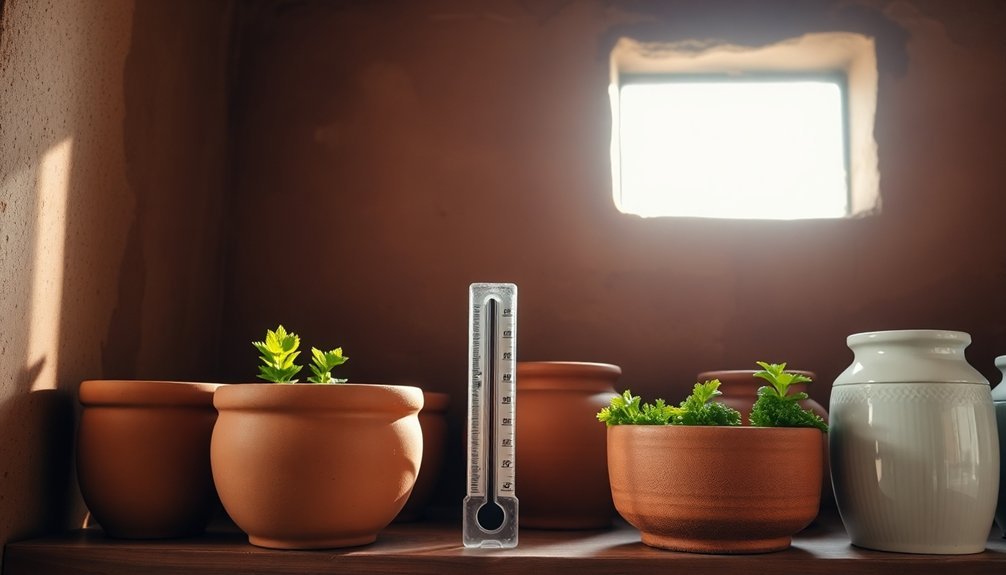
Throughout history, temperature control using clay pots has relied on a remarkably effective natural process: evaporative cooling. You'll find this method mirrors how your body cools itself through perspiration, as water evaporating from the clay pot's surface draws heat away from its contents. Traditional clay pot craftsmanship continues to serve communities with limited access to modern refrigeration.
When you place food items in a properly maintained clay pot cooler, you're tapping into a technique that can lower internal temperatures by up to 10°C compared to the surrounding environment.
To maximize the cooling effect, you'll need to maintain specific storage conditions. Keep your clay pot in a shady, well-ventilated area, and guarantee the sand between the pots stays consistently wet.
You'll achieve the best results in low-humidity, high-temperature environments.
Three key benefits of clay pot cooling through history:
- Extended food preservation – leafy greens last 4+ days instead of one
- Reduced market trips – storage times increase from 2-3 days to 3 weeks for many vegetables
- Economic savings – less food spoilage means lower household expenses
When you maintain proper conditions, you're using the same principles that have kept food fresh for generations, proving that sometimes the simplest solutions are the most enduring.
Moisture Management in Clay Vessels
You'll find that clay vessels excel at controlling natural water loss through their remarkable ability to retain and regulate moisture content.
The porous, breathable surface of clay pots lets water molecules move slowly through microscopic channels, creating an ideal environment for food preservation.
These natural properties work together to maintain a consistent humidity balance, which helps keep your stored fruits and vegetables fresh for longer periods.
Natural Water Loss Control
Moisture management stands at the heart of clay pot cooling effectiveness. When you use a clay pot cooler, you're harnessing the power of natural evaporation to control water loss from your fruits and vegetables. The wet sand between the pots and the damp cloth covering create an ideal environment that helps your produce retain its natural moisture while staying cool.
You'll find that maintaining proper humidity levels is essential for extending the shelf life of your food. The clay pot system works by creating a microclimate that's up to 10°C cooler than the surrounding air, while keeping humidity at ideal levels for food preservation.
Here's how you can maximize moisture control in your clay pot cooler:
- Keep the sand consistently moist but not waterlogged – this guarantees continuous evaporative cooling.
- Cover the pot with a damp cloth to maintain humidity levels and enhance the cooling effect.
- Store leafy greens and vegetables that benefit from higher humidity levels – you'll see their shelf life extend from one day to over four days.
Breathable Surface Properties
The unique porosity of clay vessels creates a natural breathing system that actively manages moisture levels in your stored food. When you store food in clay pots, the microscopic pores allow continuous air circulation through the walls, preventing moisture buildup that could lead to spoilage. These tiny openings work like a natural ventilation system, maintaining ideal humidity levels around your food.
You'll find that clay's breathable surface regulates temperature effectively, keeping your food cooler in hot weather and warmer in cold conditions. This natural insulation helps protect your stored items from sudden temperature changes that could affect their freshness.
The porous nature of clay also prevents salt accumulation, which is essential for preserving food quality. If you're storing items with high salt content, the clay absorbs excess minerals that might otherwise concentrate and affect the food's taste or preservation.
The pot's surface continuously exchanges moisture with its environment, releasing excess humidity when conditions are too damp and retaining necessary moisture when it's too dry. This self-regulating feature means you won't need to worry about your food becoming too wet or dried out.
Humidity Balance Mechanics
Inside clay vessels, balanced humidity levels remain essential for preserving food freshness through a sophisticated moisture management system.
You'll find that the clay's natural properties create an even evaporation process, where water slowly dissipates through the vessel's walls, maintaining consistent humidity levels and preventing rapid moisture loss that could compromise your food's quality.
The clay's remarkable porous structure works like a moisture regulator, absorbing and releasing water in response to environmental conditions. This natural mechanism helps maintain relative humidity levels between 90-100% inside the pot, creating ideal conditions that slow down food deterioration and preserve nutritional value.
- The clay's even evaporation process prevents moisture fluctuations that typically lead to food spoilage
- The porous structure creates a natural humidity buffer, protecting your food from excessive dryness or dampness
- The consistent moisture levels help maintain food's cellular structure, extending shelf life and preserving texture
Through this intelligent humidity management, you're able to keep your stored foods fresher for longer periods while maintaining their natural qualities.
The clay's ability to regulate moisture creates a protective environment that greatly reduces the risk of premature food degradation.
Natural Cooling System Mechanics
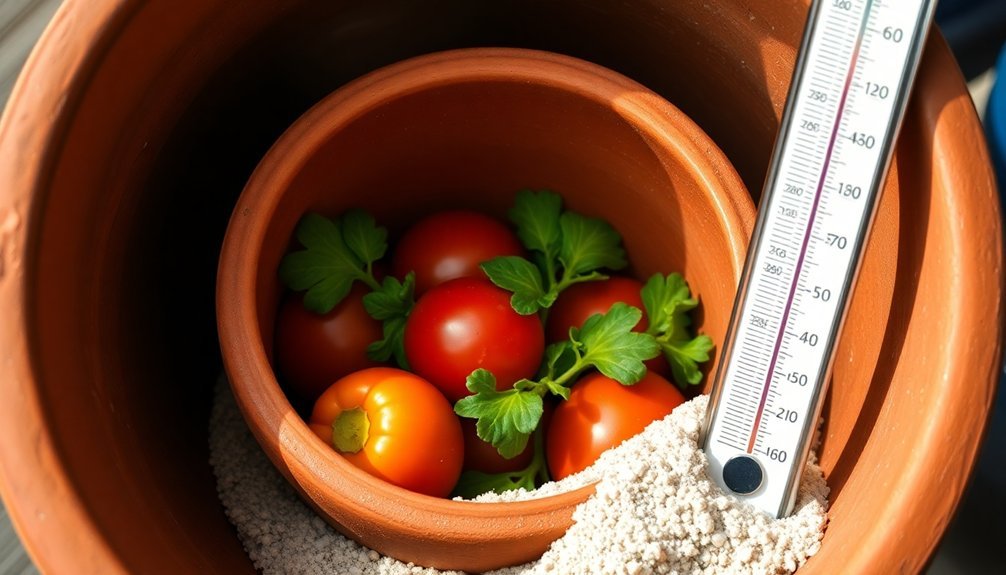
Traditional clay pot cooling systems operate through a remarkably simple yet effective evaporative process. When water evaporates from the outer surface of the clay pot, it draws heat away from the interior, creating a natural cooling effect similar to how your body cools itself through perspiration. This process can lower the internal temperature by up to 10°C compared to the surrounding air.
The system's design typically consists of a smaller pot nested inside a larger one, with wet sand filling the gap between them. You'll need to place the entire setup in a shaded, well-ventilated area and keep it covered with a damp cloth to maintain ideal cooling. The sand acts as a water reservoir, continuously feeding moisture to the clay walls for sustained evaporation.
When you properly maintain this natural cooling system, you'll extend the shelf life of your produce considerably. For instance, leafy greens that typically last only one day can stay fresh for over four days.
This cooling method proves especially valuable in areas without electricity, as it's both cost-effective and environmentally friendly, requiring only water and natural materials to function.
Cultural Significance of Clay Storage
You'll find that clay pot storage embodies centuries of ancestral wisdom, with techniques perfected across diverse cultures from ancient Mesopotamia to the American South.
Traditional preservation methods, including those practiced by enslaved potters like Dave Drake, showcase how these vessels became essential tools for surviving harsh seasons and maintaining food security.
The cultural significance of clay storage extends beyond mere utility, as these pots tell stories through their inscriptions and residues, connecting modern societies to the practical knowledge of their forebears.
Traditional Preservation Methods
Spanning countless generations and cultures, clay pot storage has served as a cornerstone of food preservation methods worldwide. You'll find these fired clay vessels were remarkably effective at preserving foods through various techniques, from dry curing with salt and spices to storing meat in brines during warm weather.
The alkaline-glazed stoneware proved especially durable, resisting water dissolution while keeping out unwanted pests through well-fitted lids and stoppers.
These time-tested preservation methods included:
- Layering butter between salt for winter storage, ensuring longer-lasting dairy products
- Preserving chopped suet and beef fat using molasses as a natural preservative
- Creating protective brines for meat storage, combining salt, saltpeter, sugar, and spices
You'll discover that these preservation techniques weren't just practical – they were vital for survival. In smokehouses and plantation kitchens, clay pots played a pivotal role in large-scale food storage.
The vessels' effectiveness came from their careful construction and the chemical changes that occurred during firing, making them resistant to weather and wear.
Today, archaeologists can still study food residues in these pots, helping us understand the dietary practices of past populations.
Ancient Storage Wisdom
Beyond their practical preservation capabilities, clay pots tell a rich story of human ingenuity across civilizations. You'll find evidence of clay pot usage spanning from Ice Age hunters in Russia to colonial-era India, where communities adapted these vessels to their specific needs.
What's particularly fascinating is how different cultures independently discovered the ideal properties of clay for food storage. Here's how ancient civilizations maximized clay pot benefits:
| Region | Storage Innovation |
|---|---|
| India | Repurposed colonial jars for pickle storage, utilizing clay's antiseptic properties |
| Japan | Developed Iga donabe for specific cooking and preservation techniques |
| Russia | Created heat-resistant vessels for cooking game meat during harsh winters |
| Americas | Used micaceous clay for enhanced thermal properties and natural seasoning |
You'll notice that while materials varied, from micaceous earthenware to sandware, the fundamental understanding of clay's preservation capabilities remained consistent. These unglazed pots naturally regulated moisture through their porous structure, while later glazed versions offered additional durability. This ancient wisdom wasn't just about storage—it represented a deep understanding of materials that continues to influence modern preservation techniques.
Archaeological Evidence and Discoveries
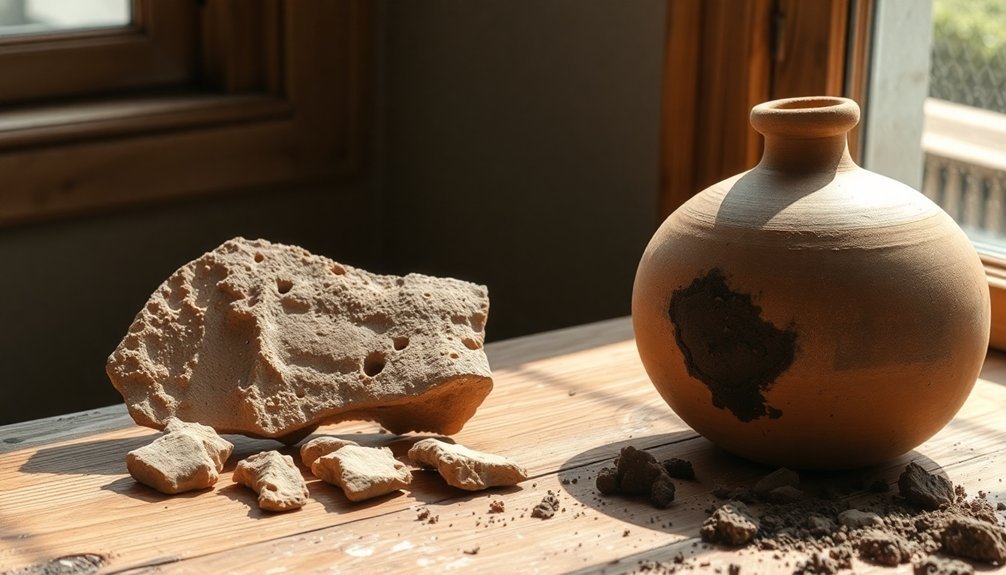
Archaeological discoveries reveal three pivotal findings about ancient clay pot usage: they emerged around 15,000 years ago among hunter-gatherers, primarily served to process aquatic foods, and played a significant role in early food preservation methods.
Chemical analysis and diagnostic lipids found in charred deposits on ancient pottery tell a fascinating story about our ancestors' food processing techniques.
You'll find particularly compelling evidence in Japan's Late Pleistocene Jomon vessels, where researchers discovered residues indicating extensive fish preparation.
In Central Europe, archaeologists uncovered perforated clay pots from 7,000 years ago that were used for cheese-making, separating curds from whey.
- Marine Resource Processing: Ancient clay pots contained lipids from aquatic organisms, confirming their primary use in cooking fish and seafood.
- Preservation Innovation: Stable isotope data shows these vessels weren't just for cooking – they enabled fermentation, curing, and pickling of seasonal foods.
- Climate Adaptation: The emergence of pottery coincided with climate change, suggesting these vessels helped communities adapt by maximizing shoreline and river-bank food resources.
Regional Clay Storage Variations
Anyone exploring traditional food storage methods will find remarkable variations in clay pot designs across different regions, particularly in areas with limited access to modern refrigeration.
In Sub-Saharan Africa, especially Mali, you'll find clay pot coolers that use a nested design, where a smaller pot fits inside a larger one with sand filling the gap between them.
You'll notice these coolers typically cost between $5 and $40, making them accessible to local communities. They're constructed using locally available materials, and you can adjust their size based on your specific needs.
The design's effectiveness comes from combining the clay pots with sand and a cloth cover, which work together to maintain ideal humidity and temperature levels.
When you look at the impact, you'll see how these storage solutions have transformed local communities. They've reduced food spoilage, decreased the frequency of market visits, and improved nutrition by keeping produce fresh longer.
In Mali, while people traditionally used clay pots for water cooling, they're now learning to apply this technology to vegetable storage through dedicated training programs that teach proper assembly and maintenance techniques.
Material Properties of Clay
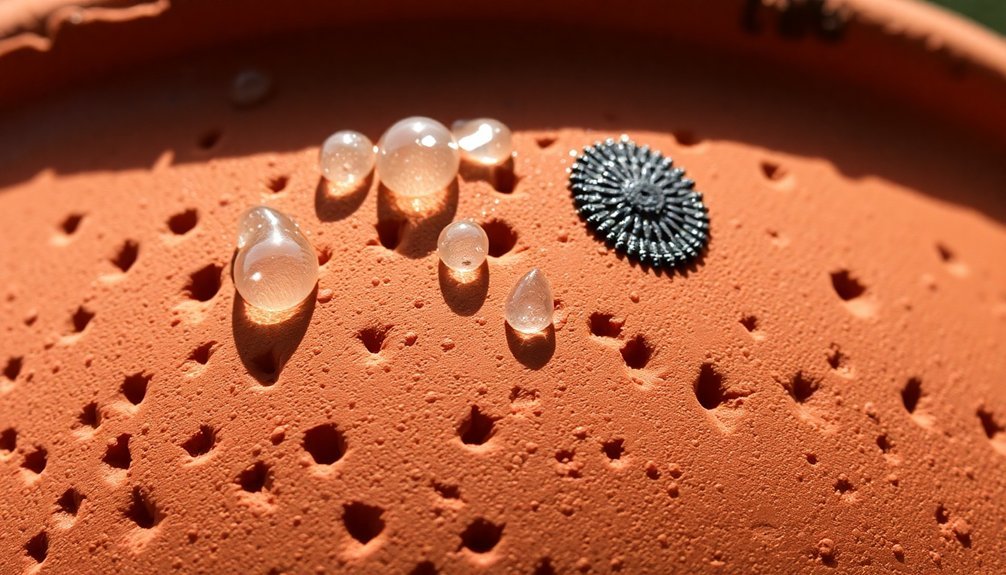
Clay's remarkable molecular structure explains its effectiveness in food preservation. The layered arrangement of clay minerals, held together by water molecules through hydrogen bonds, creates a material that's both moldable and shape-retaining.
When craftsmen work with clay minerals like halloysite and montmorillonite, they're utilizing materials that naturally form into nanotubes and nanoplatelets, enhancing the pot's barrier and mechanical properties.
The material properties of clay directly contribute to food preservation through:
- Gas barrier functionality – Clay's structure prevents oxygen from entering while controlling water vapor escape, creating an ideal environment for food storage.
- Temperature regulation – The material's ability to facilitate evaporative cooling can reduce ambient temperature by up to 10°C, maintaining consistent conditions.
- Chemical interactions – Clay minerals can combine with other materials like essential oils to create antibacterial properties, actively fighting against harmful microbes.
These intrinsic properties make clay an exceptional material for food storage.
You'll find that the nanoscale structure of clay allows for precise control of gas permeability, while its ability to absorb and release substances helps maintain perfect preservation conditions.
Traditional Construction Techniques
While clay's molecular properties make it ideal for food preservation, the effectiveness of a clay pot ultimately depends on how it's constructed. You'll find three main techniques used in traditional clay pot making: pinching, coiling, and slab building.
When you're using the pinch method, you'll start with a clay lump, creating a center hole with your thumb before stretching the walls outward.
For larger pots, you'll want to use the coil technique, where you'll roll clay into long strips and stack them carefully, securing each layer with scoring and slip.
If you're aiming for more geometric shapes, you'll find the slab method most effective, rolling out flat pieces and joining them at precise angles.
Regardless of the technique you choose, you'll need to confirm proper bonding between clay pieces and smooth finishing of all surfaces.
You'll want to scrape both interior and exterior surfaces with a rib tool to eliminate seams and fill any gaps.
The final steps include cutting the rim straight and smoothing all surfaces with a damp sponge, confirming your pot will be properly sealed for ideal food preservation.
Preservation Duration and Effectiveness
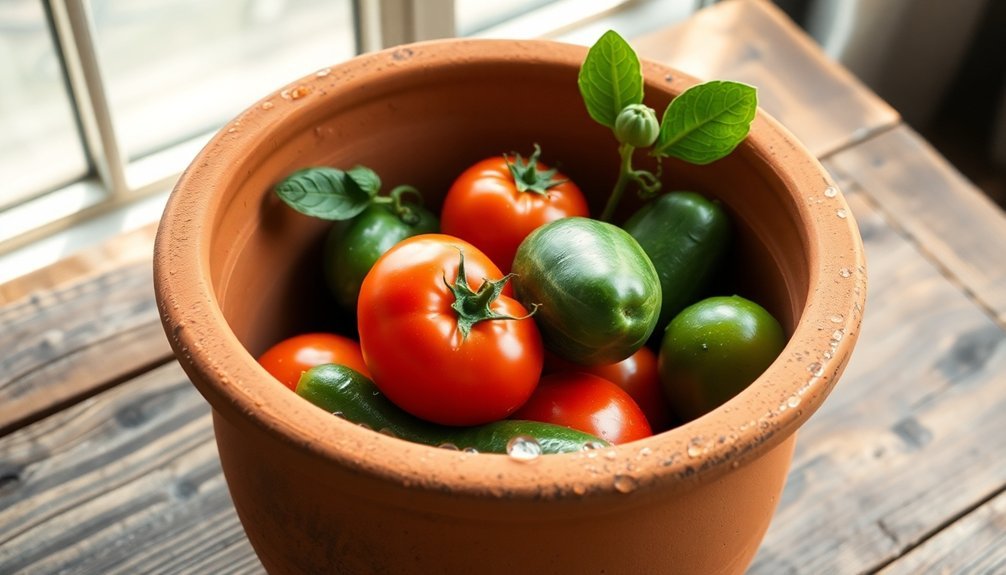
Through the natural process of evaporative cooling, clay pots create an impressively effective food preservation system.
You'll find that these devices can lower internal temperatures by up to 10°C below the surrounding environment, creating ideal conditions for storing fresh produce. This cooling effect, combined with maintained humidity levels, considerably extends the shelf life of your fruits and vegetables.
The preservation effectiveness is particularly notable for common household produce. You can expect your leafy greens to stay fresh for more than four days, compared to just one day using conventional storage methods.
The system's impact on food preservation is evident through user experiences:
- 98% of users report reduced food waste, allowing them to maximize their grocery purchases
- You'll make fewer trips to the market, as demonstrated by 95% of users who reported decreased travel time
- Your fruit and vegetable consumption is likely to increase, as shown by 88% of users who incorporated more fresh produce into their diets
The system's effectiveness isn't just theoretical – 100% of users confirm that clay pot coolers outperform their previous storage methods, making them a reliable solution for food preservation.
Environmental Impact of Clay Storage
Beyond their impressive preservation capabilities, clay pot storage systems offer remarkable environmental benefits you won't find with conventional refrigeration. You'll greatly reduce food waste when using these systems, as they extend the shelf life of fruits and vegetables, supporting key UN Sustainable Development Goals while lowering carbon emissions from decomposing produce.
What's particularly impressive is how clay pot coolers achieve their cooling effect with minimal resource consumption. You'll only need 1 to 3 liters of water daily, which is far less than what's required to grow the stored produce. Since they don't require electricity, you're saving energy while relying on locally available materials that have a lower manufacturing impact.
You're also contributing to broader ecosystem preservation when you use clay pot storage. By reducing food waste, you're helping decrease the pressure on agricultural lands, preserving soil health, and supporting biodiversity.
The system's minimal packaging requirements mean you'll generate less waste, and since clay pots are made from natural materials, they're safer to dispose of than conventional storage solutions. You'll find they're particularly valuable in water-scarce regions, where their efficient water usage makes them an environmentally conscious choice.
Modern Applications of Ancient Methods
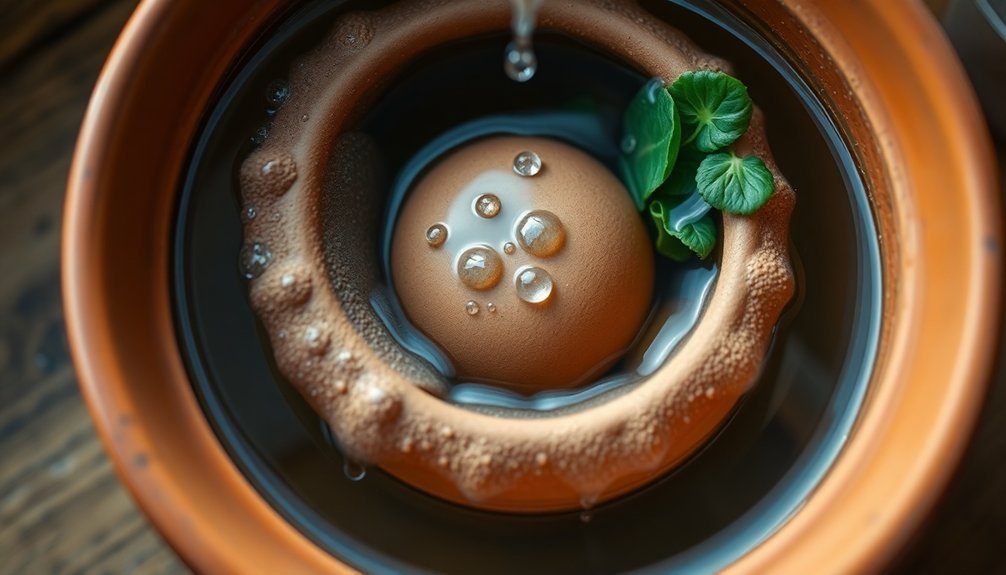
You'll find ancient clay pot cooling systems making a remarkable comeback worldwide, with communities from Mali to India embracing this sustainable storage solution.
The simple yet effective heat transfer technology continues to prove its worth, as clay vessels can reduce interior temperatures by up to 10°C below ambient conditions while maintaining ideal humidity levels.
Modern science has validated what traditional societies knew for centuries: these low-cost coolers greatly extend produce shelf life, with current studies showing they can preserve leafy greens for more than four times longer than conventional storage methods.
Sustainable Storage Goes Global
In recent years, ancient food preservation methods have experienced a remarkable revival alongside modern eco-friendly storage solutions. You'll find traditional techniques like drying, fermentation, and curing being adapted to meet contemporary needs while reducing environmental impact.
From glass containers to clay pot coolers, sustainable storage methods are transforming how you preserve food across different climates and cultures.
These eco-conscious solutions aren't just trendy alternatives; they're proving essential in the global fight against food waste. You can now combine time-tested methods with innovative materials like silicone and soy wax products to create effective, environmentally responsible storage systems that work in diverse settings.
- Clay pot coolers provide electricity-free storage in hot regions, making fresh produce accessible where refrigeration isn't available.
- Reusable containers and wraps made from sustainable materials help you reduce plastic waste while maintaining food freshness.
- Traditional preservation methods like fermentation and drying not only extend shelf life but also enhance nutritional value, supporting both environmental and health goals.
The global adoption of these sustainable storage solutions demonstrates how ancient wisdom can effectively address modern challenges in food preservation and waste reduction.
Heat Transfer Technology Lives
Modern science continues to back up what ancient civilizations knew all along: clay pots excel at heat transfer and preservation.
You'll find that clay pots distribute heat more evenly than modern cookware, preventing those harsh temperature fluctuations that can destroy nutrients. They're natural heat regulators – absorbing, retaining, and distributing warmth uniformly throughout your food. This gentle cooking process helps maintain your food's nutritional value while using less energy than conventional methods.
What makes clay pots particularly effective is their porous nature. When you're cooking, these microscopic pores allow steam to circulate naturally, creating an environment where food stays moist without getting waterlogged. You won't need to worry about dried-out dishes or burnt bottoms. Instead, you'll get consistently tender, flavorful results.
Today's researchers are finding new ways to integrate these time-tested principles with modern technology. While flash-heating methods blast food with extreme temperatures, clay pot cooking offers a more natural approach that's both energy-efficient and nutrient-preserving.
You're not just using an ancient cooking method – you're participating in a sustainable practice that's finding new relevance in today's environmentally conscious world.
Traditional Wisdom Meets Science
When ancient wisdom collides with scientific validation, remarkable breakthroughs emerge in food preservation and storage. You'll find that traditional clay pot cooling systems aren't just folklore – they're scientifically proven to reduce temperatures by up to 10°C through evaporative cooling, mimicking the same principle that keeps you cool when you perspire.
The science behind these ancient methods has led to modern adaptations that you can implement today. By using a simple nested pot system with sand and regular watering, you're creating an affordable refrigeration alternative that costs between $5 and $40.
This traditional method has been validated by impressive statistics, with studies showing 98% of users reporting less food waste and 88% increasing their fresh produce consumption.
- Natural temperature regulation: The porous nature of clay allows for ideal moisture control and heat distribution
- Enhanced nutrition: Clay vessels naturally enrich food with essential minerals while neutralizing acidic components
- Sustainable cooling: The evaporative cooling mechanism requires no electricity, making it an environmentally conscious choice for food preservation
Frequently Asked Questions
How Often Should the Sand Between Clay Pots Be Replaced?
You don't need to replace the sand regularly – just keep it moist daily. Only replace it when it becomes too compacted or contaminated. Monitor the sand's condition and maintain its wetness for peak cooling performance.
Can Clay Pot Coolers Be Used to Store Dairy Products?
You shouldn't store dairy products in clay pot coolers as they require lower temperatures. While traditional clay curd pots work well for specific dairy items, regular clay coolers can't maintain the proper temperature for safe storage.
What Happens if Rainwater Gets Into the Clay Pot Cooler?
If rainwater gets into your clay pot cooler, you'll notice reduced cooling efficiency as waterlogged sand disrupts evaporation. You'll need to drain excess water and clean the system to restore its proper function.
Do Different Types of Clay Affect the Cooling Efficiency?
Yes, clay type greatly affects cooling efficiency. You'll get better results with more porous clays like Bentonite that enhance water retention and evaporation, compared to less absorbent options like Kaolin or stoneware.
Can Clay Pot Coolers Be Used in High-Humidity Coastal Areas?
You'll find clay pot coolers less effective in coastal areas due to high humidity reducing evaporation rates. While they'll still work somewhat, you won't get the same cooling benefits as in drier climates.
In Summary
You'll find clay pots remain a remarkably effective storage solution, even by today's standards. Through natural evaporative cooling, moisture regulation, and temperature control, these vessels have kept food fresh for thousands of years. Whether you're storing grains, vegetables, or liquids, clay pots' time-tested benefits and eco-friendly properties make them worth considering as a sustainable alternative to modern storage methods.

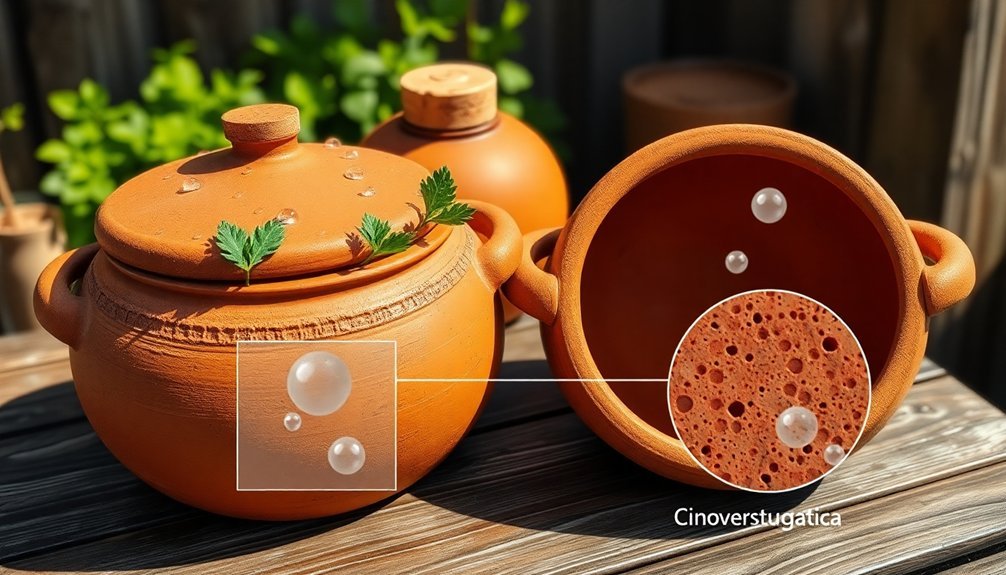



Leave a Reply